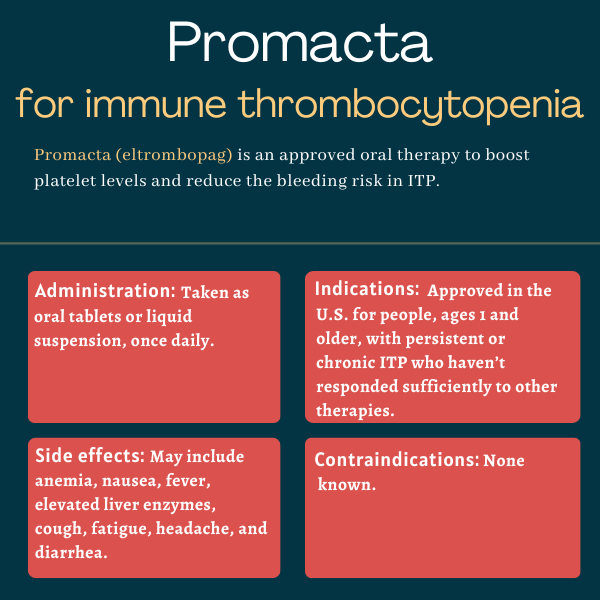Promacta (eltrombopag) for immune thrombocytopenia
Last updated July 10, 2025, by Lindsey Shapiro, PhD

What is Promacta for immune thrombocytopenia?
Promacta (eltrombopag) — sold as Revolade in most places outside the U.S. — is an oral therapy approved for children and adults with immune thrombocytopenia (ITP) for whom other treatments haven’t worked well enough.
The medication works by mimicking the activity of thrombopoietin, a hormone that stimulates certain bone marrow cells to make more platelets, the cell fragments important for blood clotting that are lost in ITP due to abnormal immune attacks.
By helping to boost platelet production, Promacta seeks to combat this loss and lower the associated risk of significant bleeding in people with ITP. It may also help rebalance immune activity in ways that protect platelets against immune-mediated destruction.
Promacta/Revolade is sold by Novartis, and generic versions are available in the U.S. and elsewhere. The medication is also approved for low platelet counts, or thrombocytopenia, in certain people with chronic hepatitis C, and for severe aplastic anemia, another rare blood disorder.
Therapy snapshot
| Brand name: | Promacta |
| Chemical name: | Eltrombopag |
| Usage: | Used to increase platelet counts and lower bleeding risk in ITP |
| Administration: | Oral tablets or liquid suspension. |
Who with immune thrombocytopenia can take Promacta?
Promacta is approved in the U.S. for treating thrombocytopenia in adults and children, ages 1 year and older, with persistent or chronic ITP who have insufficiently responded to at least one of these standard treatments:
- corticosteroids
- immunoglobulins
- spleen removal (splenectomy).
It should only be used by ITP patients whose degree of thrombocytopenia and clinical condition leaves them at an increased risk for bleeding.
There are no specific contraindications for Promacta’s use, but it does come with a boxed warning for the risk of possibly severe or life-threatening liver toxicity, particularly when it’s used in some people with chronic hepatitis C.
Promacta shouldn’t be used by people with myelodysplastic syndrome, a bone marrow disorder that can sometimes be confused with ITP.
Promacta is approved for similar indications in other regions, including Canada and the European Union, under the brand name Revolade.
How is Promacta administered in immune thrombocytopenia?
Promacta is taken orally, via tablets or a liquid suspension, once a day. It should be taken:
- without a meal or with a meal low in calcium
- at least two hours before or four hours after other medications, calcium rich foods, or certain supplements.
Tablets should be swallowed whole and intact. The oral suspension comes as a powder that has to be dissolved in water before use. Patients using the oral suspension, or their caregivers, should be trained on how to prepare and administer it.
The recommended starting dose is either 12.5 mg, 25 mg, or 50 mg depending on the person’s age, ethnicity, and liver health. Healthcare providers may adjust the dose as needed to maintain a platelet count sufficient to prevent bleedings and avoid excessive platelet counts, which can increase the risk of blood clots.

Promacta in immune thrombocytopenia clinical trials
Promacta’s approval in the U.S. was supported mainly by results from several Phase 2 and 3 clinical trials and an open-label extension study that collectively enrolled about 300 adults and 170 children, ages 1 year and older, with persistent or chronic ITP despite previous treatment.
The safety and efficacy of Promacta in adult patients was demonstrated in:
- The Phase 2 TRA100773 trial (NCT00102739), where about 1.5 months of Promacta treatment led to higher rates of platelet response — where platelet levels reach a threshold presumed to lower the risk of bleeding — than a placebo. The therapy was also associated with lower bleeding rates.
- The Phase 3 RAISE trial (NCT00370331), where Promacta significantly increased the odds of a platelet response, by eight times, relative to a placebo after six months of treatment.
- The EXTEND study (NCT00351468), which enrolled participants from prior Promacta trials and showed that long-term Promacta was safe and effective for maintaining platelet responses and reducing bleedings.
Similar benefits in children and adolescents were shown in:
- The Phase 2 PETIT study (NCT00908037), where about 1.5 months of treatment with Promacta significantly increased the odds of a platelet response by fourfold, and decreased the chances of clinically significant bleeding by 79% relative to a placebo.
- The Phase 3 PETIT2 trial (NCT01520909), in which about three months of Promacta treatment resulted in 18 times higher odds of achieving a sustained platelet response compared with a placebo. Rates of clinically significant bleedings were also lower among Promacta-treated patients.
Common side effects of Promacta
The most common side effects of Promacta across all indications for which it is used include:
- anemia (low red blood cell counts)
- nausea
- fever
- elevated blood levels of alanine aminotransferase, a liver enzyme
- cough
- fatigue
- headache
- diarrhea.
Other rare, but potential serious complications that can occur with Promacta include:
- Liver toxicity, as mentioned in the boxed warning, which can be severe or life-threatening. As such, liver function should be carefully monitored before Promacta is initiated and during treatment.
- Blood clots and related complications, which can occur due to increased platelet counts. This is why dosing guidelines should be carefully followed and complete platelet normalization shouldn’t be attempted.
- New or worsening cataracts, a clouding of the eye’s lens that can affect vision.
Promacta should be stopped if platelet counts do not increase to a level sufficient to prevent clinically important bleeding after a month of using the maximum dose. Excessively high platelet counts or persistently abnormal liver test findings may also warrant discontinuing treatment.
Bleeding Disorders News is strictly a news and information website about the disease. It does not provide medical advice, diagnosis, or treatment. This content is not intended to be a substitute for professional medical advice, diagnosis, or treatment. Always seek the advice of your physician or other qualified health provider with any questions you may have regarding a medical condition. Never disregard professional medical advice or delay in seeking it because of something you have read on this website.
Recent Posts
- Woman with TTP gets new hip thanks to tailored Adzynma dosing
- With chronic illness, conserving energy over the holidays is a must
- New ‘needle in the haystack’ antibody-based therapies target ITP
- Seragene lands funding for new therapies for bleeding disorders
- Early plasma therapy helps woman with TTP deliver healthy baby





